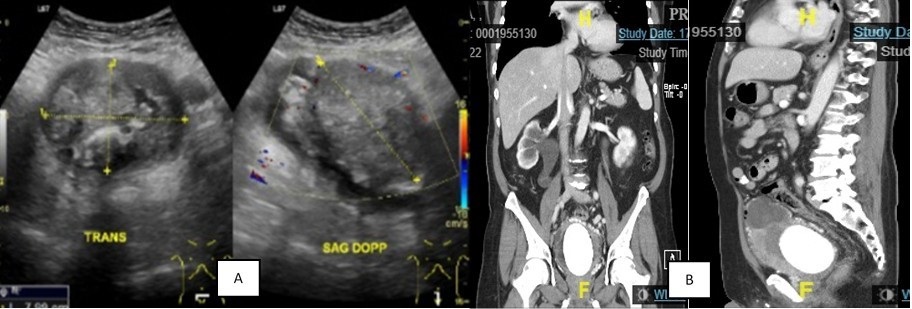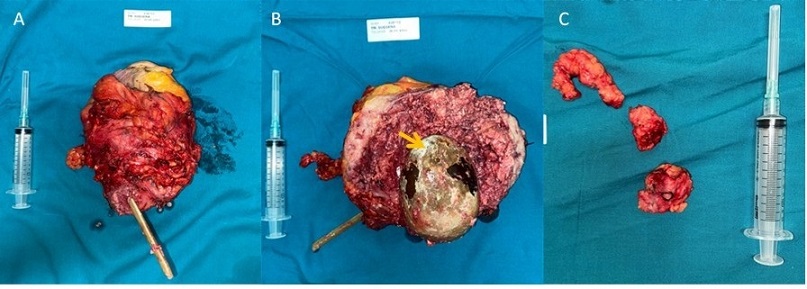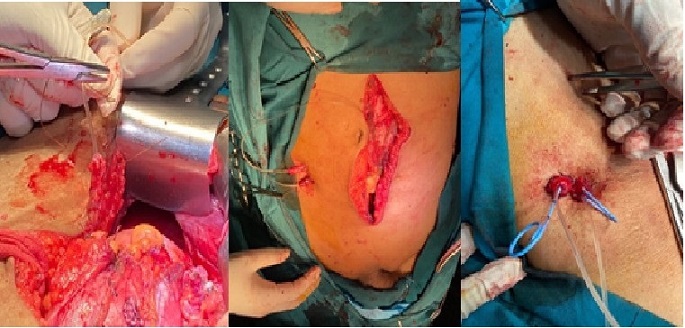Squamous Cell Bladder Cancer Associated with Large Bladder Stone: Literature Review and Its Case Report
Download
Abstract
Bladder cancer is the most common urinary tract malignancy. Radical cystectomy is preferred as gold standard therapy for non-metastatic SCC, reflected from better survival rates than other treatment options such as partial cystectomy, chemotherapy, and radiation. Several factors are associated with the occurrence of bladder cancer, including bladder stone and infection ; such conditions suggestively could cause chronic irritation on the bladder surface epithelial, causing cancerous lesion to arise. Several literatures have showed positive outcome of patients with bladder cancer that underwent radical cystectomy. Thus, it is recommended to be performed on bladder cancer cases. Hereby we present a case of a 50-years old male who underwent radical cystectomy and bilateral ureterocutaneoustomy after previous trans urethral resection of bladder tumor (TURB-T) due to squamous cell bladder cancer. At the time of admission, he had bladder stone that based on imaging result, has already penetrated adjacent tissues. We also conducted literature review to assess our case with the other reports regarding the outcome of radical cystectomy for bladder SCC.
Introduction
Bladder cancer is the most common urinary tract malignancy. The mortality rate of this neoplasm is approximately 2.1% of all cancer – associated mortalities [1]. Bladder cancer more likely occurs in male than female [2].
Several factors are associated with its occurrence, with the most commonly reported are smoking, urinary bladder infection, and bladder stone. The potential mechanism by which these conditions could raise the risk of BC occurrence is because of carcinogenic property exerted by smoking ; as for infection and bladder stone, the cancerous lesion could developed due to chronic irritation / epithelial lining disruption caused by these agents [3].
Bladder stone, one of the significant risk factor of bladder cancer, is a medical condition characterized by the deposition of solid calculi within the bladder cavity. Bladder stones are considered as an uncommon entity in Western countries. The most severely impacted regions are those in the Middle East, North Africa, Thailand, Indonesia, and Myanmar. The risk factor of bladder stone is correlated with urinary stasis, as seen in patients with benign prostatic hyperplasia and neurological bladder dysfunction [4].
Based on the histological features, bladder cancer is classified into 4 types, with the urothelial cell carcinoma (UCC) or transitional cell carcinoma accounts 90% of all bladder cancer cases [5]. However, the term ‘transitional cell carcinoma’ has been replaed by the World Health Organization (WHO). Urothelial cell carcinoma mostly arises in bladder but also could affect other urothelial lining along the urinary tract [6]. About 10% of cases comprised of non-urothelial cell carcinoma such as 2-5% squamous cell carcinoma (SCC), 0,5-2% adenocarcinoma, and <1% of small cell carcinoma [7].
SCC consists of 2 subtypes, bilharzia squamous cell carcinoma (B-SCC) and non-bilharzia squamous cell carcinoma (NB-SCC). Both subtypes have different clinicopathological characteristics [8]. Non-bilharzia squamous cell carcinoma mostly occurs due to indwelling catheter and large bladder stone.
Radical cystectomy is preferred as gold standard therapy for non-metastatic SCC, reflected from better survival rates than other treatment options such as partial cystectomy, chemotherapy, and radiation. In this report, we present patient with SCC bladder cancer due to large bladder stone who performed radical cystectomy and bilateral ureterocutaneostomy.
Case Report
A 50-years-old male with no history of surgery, chemotherapy, and radiation underwent radical cystectomy and bilateral ureterocutaneoustomy after previous trans urethral resection of bladder tumor (TURB-T) histopathological analysis showed infiltrating urothelial carcinoma with squamous differentiation (pT1NxMx) that leads to squamous cell bladder cancer. Following the TURBT procedure, ultrasonography and magnetic resonance imaging (MRI) with contrast were conducted. Prior to admission, the patient had hematuria for about 3 months.
Ultrasonography revealed solid mass that almost completely occupied entire bladder, bilateral pelvic ectasia with proximal ureteral dilation, and vesicolithiasis. There were mass size approximately 7.40 x 5.18 x 9.37 cm. Positive color doppler of the mass indicates active intralesion vascularization. CT displayed intraluminal bladder mass which apparently had infiltrated the prostate. Large bladder stone the size of 15.0 x 10.3 x 5.2 cm and bilateral pelvocalyectasis were also found in the imaging (Figure 1).
Figure 1. Large Bladder Stone the Size of 15.0 x 10.3 x 5.2 cm and Bilateral Pelvocalyectasis were also Found in the Imaging.

As the patient lived in rural areas and hardly had access to healthcare facility, he overlooked the stone obstructive symptoms as it was often relieved by changing positions.
Radical cystectomy and ureterocutaneoustomy were held for mass removal. Lower midline incision was made transperitonially above and under the umbilicus. We separated both urethra and bladder neck then entire bladder and the surrounding lymph nodes were removed. The specimens were sent for histological investigation resulting final diagnosis of squamous cell bladder cancer cT4bN1M0 (Figure 2).
Figure 2. The Specimens were Sent for Histological Investigation Resulting Final Diagnosis of Squamous Cell Bladder Cancer cT4bN1M0.

During ureterocutaneostomy, we placed double J stent through the dissected ureters and brought both terminal ends into the surface of abdomen. The stomas were made at the right side of umbilicus (Figure 3).
Figure 3. The Stomas were Made at the Right Side of Umbilicus.

Materials and Methods
As for the literature review, we gathered several from PubMed, Cochrane Library, and Google Scholar databases. The keywords used (for each of databases) were comprised of “bladder cancer” ; “bladder stone” ; “radical cystectomy” ; and “ureterocutaneoustomy”. We further selected the matched and relevant articles and reports to be reviewd in our study.
Discussion
Bladder squamous cell carcinoma (B-SCC) is more prevalent in Middle East, the Carribean, Southeast Asia, and South America where schistosomiasis parasitic infection became endemic. Meanwhile, NB-SCC are mainly found in western countries and usually diagnosed at advanced stages particularly at seventh stages of life. [9]. Therefore, NB-SCC has worse prognosis than B-SCC which often occurs in fifth decade [8].
Environmental and occupational exposure have also been identified as contributing factors in development of bladder cancer. Tobacco smoking by far became the major risk factor for both UCC and SCC, where smokers are 2,5 times higher risk than non-smokers [10]. Genetic predisposition is also thought to have a correlation with bladder cancer carcinogenesis based on family history of bladder cancer [11].
Another significant medical condition that could contribute to the occurrence of bladder cancer is bladder stone formation. Bladder stones can form in healthy people who do not have any anatomical deformities, foreign bodies, strictures, or infections ; but typically formed as a result of urinary stasis, as seen in the cases of benign prostatic hyperplasia (BPH) or neurogenic bladder. The development of bladder stones is also not always predisposed by the presence of upper urinary tract calculi. Specific symptoms and a considerable cause of discomfort are also brought on by bladder stones [3].
The patient in our case complained urinary obstructive symptoms that were often relieved by changing positions during micturition.
The pathogenesis of bladder cancer related to bladder stone has been established by several studies [12,13]. Chronic urinary tract infections, persistent urinary catheters, bladder calculi, foreign objects, intravenous Bacillus Calmette-Guerin, and prolonged exposure to cyclophosphamide are examples of conditions that can cause chronic bladder irritation [12]. In a case-control study, a history of bladder stones was linked to an increased risk of bladder cancer by 2 times. Considering the biomolecular aspect, chronic mucosal injury from long-standing bladder stones has been linked to SCC of the bladder through inflammation and breakdown of the protective glycosaminoglycan layer, by which this condicition could raise the risk of the development of cancerous urothelial lesion. Prolonged urothelial cells exposure to proinflammatory cytokines also contributes to the pathogenesis of bladder SCC due to bladder stone [13,14].
A similar case reported by Singh et al.[15] also revealed that many studies have stated the strong association between bladder stone (particulary the large one) with SCC pathogenesis. Bladder stone could be said to be large if it is unable to pass the urethra, although other study by Pitoyo et al.[16] defined ‘large’ bladder stone if it is sized of more than 40 mm. Our study presented a stone that sized approximately,15 cm; we suggest this is the largest stone that is ever reported to be associated with SCC.
Previous study revealed that radical cystectomy and urinary diversion had better effectiveness than other therapy [8]. Radical cystectomy procedure can be applied to high grade T1, advance stage of superficial bladder cancer, and muscle–invasive bladder cancer [11]. In younger people, they may suffer impotence and infertility problems due to nerve sparing during the procedure [11].
A retrospective study reported, the 5-year survival rate of bladder cancer around 48% [17]. Chemotherapy are sometimes resulting variable outcome and not routinely used [15]. From the intraoperative histological analysis of this case, this patient was diagnosed with squamous cell bladder cancer stage cT4bN1M0. Tumor has already invaded the prostate and fixed to the abdominal wall, pelvic wall, and prostate. Lymph node metastasis were also found within the true pelvis with no distant metastasis. Distant metastases in SCC are quite rare, but some case had reported bone, lung, soft tissue, adrenal glands, and brain metastases [18].
We identified seven case reports from literature on several databases related to the presented case. The majority of these cases also had large or giant bladder stone with the largest one of 14 x 9 cm. Clinically, the patients complained lower urinary tract symptoms (LUTS) include chronic progressive dysuria, straining, nocturia, frequency, intermittency, and haematuria. Other symptoms also reported such as bladder fullness, constipation, unintentional weight loss [19], suprapubic pain, orthostatic dizziness, anorexia [20]. It is not only reported in SCC of bladder, but also associated with translational cell carcinoma[18], urothelial carcinoma [12,21], osteoclast-like giant cell carcinoma [22], haemangioma, and villous adenoma [23]. Therefore, chronic LUTS with large bladder stones were should be considered and reassure the presence of malignancy [19]. Regarding the diagnostic tool to evaluate bladder
SCC, we conducted imaging studies comprised of ultrasonography, CT scan, and MRI (with contrast), with the final diagnosis of squamous cell bladder cancer cT4bN1M0. Out of seven literature we reviewed, Cho et al.[19] and Aboutal et al.[3] performed cystoscopy to evaluate direct situation of the bladder advanced imaging such as contrast-enhanced CT scan (CECT) was performed by Fernand et al.[24] and Rajaian et al.[25] with the malignant tissue reflected enhancing
– appearance. The presence of B-SCC was detected solely on the histopathological finding in the cases reported by Kirakoya et al.[26] and Haidari et al [27]. All of the histopathological findings suggested that the tumors are all invasive (the lesion has penetrated lamina propria and muscularis layer). Our patients was treated with radical cystectomy, however, despite of the effectiveness and advantages offered, only 3 out of 7 patients from literatures that agreed to underwent radical cystectomy [3,24,25]. The outcome is measured based on the mortality and symptomatic episode reported by the patients/clinicians. Mortality in such cases are reported by 3 literatures, with one patient died after refusing both cystectomy and chemotherapy [19], after underwent radical cystectomy [24], and after rejecting radical cystectomy, accompanied by severe anemia [26], a case report by Aboutal et al.[3], however, did not mention clearly the outcome of their patient. In addition, the follow up among the seven literatures ranged from 3 months [23] until 18 months [26].
In conclusion, bladder cancer is the most common urinary tract malignancy. Radical cystectomy is preferred as the gold standard therapy for non-metastatic SCC, reflected from better survival rates than other treatment options such as partial cystectomy, chemotherapy, and radiation. Patients that rejected radical cystectomy also tend to be having worse outcome. Several literatures showed positive results on radical cystectomy. Thus, it is recommended to be performed on bladder cancer cases.
Acknowledgements
The authors thank to every people contributed on the synthesis of this study.
Funding sources
This research did not receive any specific grant from funding agencies in the public, commercial, or not-for- profit sectors.
Declatation of interest
The author declare no conflict of interest.
Declaration of patient consent
We have obtained an appropriate patient consent form for his images and other clinical information to be reported in the article. The patient understands that his names and initials will not be published, and due efforts will be made to conceal his identity.
Consents and Ethics Approval
We have obtained written and oral consent from the patient to be included in this literature review and case report. Ethical approval was granted by our hospital ethical committee.
References
- Global Cancer Statistics 2020: GLOBOCAN Estimates of Incidence and Mortality Worldwide for 36 Cancers in 185 Countries Sung H, Ferlay J, Siegel RL , Laversanne M, Soerjomataram I, Jemal A, Bray F. CA: a cancer journal for clinicians.2021;71(3). CrossRef
- Epidemiology of Bladder Cancer Saginala K, Barsouk A, Aluru JS , Rawla P, Padala SA , Barsouk A. Medical Sciences (Basel, Switzerland).2020;8(1). CrossRef
- Squamous Cell Carcinoma of the Urinary Bladder Associated with a Big Bladder Stone in a 55-Year-Old Female: A Case Report Aboutaleb H, Badawy A, Gamal-eldin A, Badr-eldin M. UroToday International Journal.2011;4. CrossRef
- Epidemiology of urolithiasis in Asia Liu Y, Chen Y, Liao B, Luo D, Wang K, Li H, Zeng G. Asian Journal of Urology.2018;5(4). CrossRef
- Immunological basis in the pathogenesis and treatment of bladder cancer Thompson DB , Siref LE , Feloney MP , Hauke RJ , Agrawal DK . Expert Review of Clinical Immunology.2015;11(2). CrossRef
- Histological variants of urothelial carcinoma: diagnostic, therapeutic and prognostic implications Amin MB . Modern Pathology: An Official Journal of the United States and Canadian Academy of Pathology, Inc.2009;22 Suppl 2. CrossRef
- Histologic variants of urothelial bladder cancer and nonurothelial histology in bladder cancer Chalasani V, Chin JL , Izawa JI . Canadian Urological Association Journal = Journal De l'Association Des Urologues Du Canada.2009;3(6 Suppl 4). CrossRef
- Squamous cell carcinoma of the urinary bladder: Systematic review of clinical characteristics and therapeutic approaches Martin JW , Carballido EM , Ahmed A, Farhan B, Dutta R, Smith C, Youssef RF . Arab Journal of Urology.2016;14(3). CrossRef
- Nonurothelial cancer of the bladder Abol-Enein H, Kava BR , Carmack AJK . Urology.2007;69(1 Suppl). CrossRef
- The Role of Tobacco Smoke in Bladder and Kidney Carcinogenesis: A Comparison of Exposures and Meta-analysis of Incidence and Mortality Risks Cumberbatch MG , Rota M M, Catto JWF , La Vecchia . European Urology.2016;70(3). CrossRef
- Muscle-invasive bladder cancer in a young adult: a case report and a review of the literature Nabbout P, Eldefrawy A, Engles CD , Culkin DJ , Slobodov G. Central European Journal of Urology.2013;66(2). CrossRef
- Bladder Stones Associated with an Aggressive Plasmacytoid Variant of Urothelial Cancer: A Rare Case and Literature Review Alsheikh M, Zaman MF , Gopinath P, Qteishat A. Current Urology.2020;13(4). CrossRef
- Chronic inflammation and bladder cancer Michaud DS . Urologic Oncology: Seminars and Original Investigations.2007;25(3). CrossRef
- Posprostatectomy Lithiasis Haddad FS, Chinichian A. Urol Int.1991;46(1):221-231.
- Squamous cell carcinoma of the urinary bladder associated with large vesical calculus Singh S, Bisht N, Gupta S, Sen A, Joshi R. J Cancer Res Pract.2020;7(1):45.
- the Insidence of Bladder Squamous Cell Carcinoma in Large Bladder Stone Case Pitoyo J, Safriadi F. Indones J Urol.2015;22(1).
- Biomarkers in Non-Schistosomiasis-related squamous cell carcinoma of the urinary bladder: A review Mc M, A H, C A, S S. Critical reviews in oncology/hematology.2019;135. CrossRef
- Metastatic pattern of bladder cancer: correlation with the characteristics of the primary tumor Shinagare AB , Ramaiya NH , Jagannathan JP , Fennessy FM , Taplin M, Van den Abbeel ADe . AJR. American journal of roentgenology.2011;196(1). CrossRef
- Squamous cell carcinoma of the bladder in a female associated with multiple bladder stones Cho JH , Holley JL . BMC research notes.2013;6. CrossRef
- Primary squamous cell carcinoma of the urinary bladder presenting as peritoneal carcinomatosis Beltran H, Robinson BD , Tagawa ST . Advances in Urology.2010. CrossRef
- Urothelial carcinoma arising from a bladder diverticulum containing multiple stones: A case report Moussa M., Abou Chakra M.. Urology Case Reports.2018;20. CrossRef
- Giant dendritic struvite calculus associated with transitional cell carcinoma of the ipsilateral renal pelvis and bladder: a case report and review of the literature Dumbadze I., Crawford E. D., Mulvaney W. P.. The Journal of Urology.1979;122(5). CrossRef
- Giant bladder stone with squamous cell carcinoma of bladder: Case report and the literature review Wahyudi SS , Rozidi ARS , Zharfan RS , Setyowati D. International Journal of Surgery Case Reports.2021;79. CrossRef
- Aggressive squamous cell carcinoma of the bladder associated with a history of large bladder stone - a case report Fernando MH , Jayarajah U, Herath KB , Silva MVC , Goonewardena SAS . Clinical Case Reports.2017;5(10). CrossRef
- Squamous cell carcinoma associated with large bladder calculus Rajaian S, Kumar RM , Kekre NS . ANZ J Surg.2012;82:85-97.
- GIANT BLADDER STONE IN A PATIENT WITH TUMOR OF THE BLADDER: A RARE CO-MORBIDITY Kirakoya B., Kabore M., Pare A. K., Abubakar B. M.. Journal of the West African College of Surgeons.2018;8(3).
- Squamous cell carcinoma arising in an epidermal cyst of urinary bladder associated with vesicolithiasis: A case report and review of the literature Haidari M, Saadaat R, Malakzai HA , Abdul-Ghafar J. International Journal of Surgery Case Reports.2021;85. CrossRef
License

This work is licensed under a Creative Commons Attribution-NonCommercial 4.0 International License.
Copyright
© Asian Pacific Journal of Cancer Care , 2022
Author Details
How to Cite
- Abstract viewed - 0 times
- PDF (FULL TEXT) downloaded - 0 times
- XML downloaded - 0 times